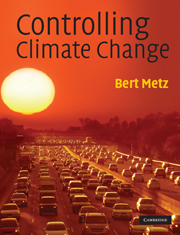Book contents
- Frontmatter
- Contents
- Preface
- 1 Climate change and its impacts: a short summary
- 2 Greenhouse gas emissions
- 3 Keeping climate change within sustainable limits: where to draw the line?
- 4 Development first
- 5 Energy Supply
- 6 Transportation
- 7 Buildings
- 8 Industry and waste management
- 9 Land use, agriculture, and forestry
- 10 How does it fit together?
- 11 Policies and measures
- 12 International climate change agreements
- Index
- Plate section
7 - Buildings
Published online by Cambridge University Press: 05 June 2012
- Frontmatter
- Contents
- Preface
- 1 Climate change and its impacts: a short summary
- 2 Greenhouse gas emissions
- 3 Keeping climate change within sustainable limits: where to draw the line?
- 4 Development first
- 5 Energy Supply
- 6 Transportation
- 7 Buildings
- 8 Industry and waste management
- 9 Land use, agriculture, and forestry
- 10 How does it fit together?
- 11 Policies and measures
- 12 International climate change agreements
- Index
- Plate section
Summary
What is covered in this chapter?
Buildings are a big user of energy, through the building materials and through heating, cooling, lighting, and use of equipment in the buildings. They contribute almost 20% to global greenhouse gas emissions, when emissions from the electricity used in buildings are included. At the same time the opportunities for energy savings and CO2 reduction are enormous. And most of these savings pay for themselves. Modern techniques now allow net zero energy buildings to be built. This chapter will investigate these possibilities and try to find out why these opportunities have not been taken advantage of and what could be done about that.
Developments in the buildings sector
Buildings are the basic infrastructure of human societies. Housing is a fundamental human need. Unfortunately many people on this planet do not yet have an adequate house. One out of three people living in cities in developing countries lives in a slum. The average number of people in Pakistan per room is three, while this is 0.5 for many countries in Europe and the USA. World population will grow by several billion people over the next 50 years. They all need proper housing. Factories, offices, schools, shops, and theatres also require buildings. And these buildings require energy: energy to build them, to heat and cool them, to cook food, to heat water, and to run the appliances and equipment used in buildings (see Box 7.1).
- Type
- Chapter
- Information
- Controlling Climate Change , pp. 181 - 208Publisher: Cambridge University PressPrint publication year: 2009



